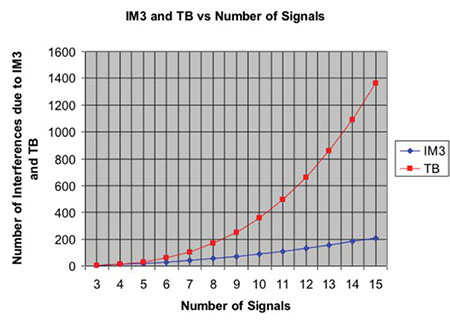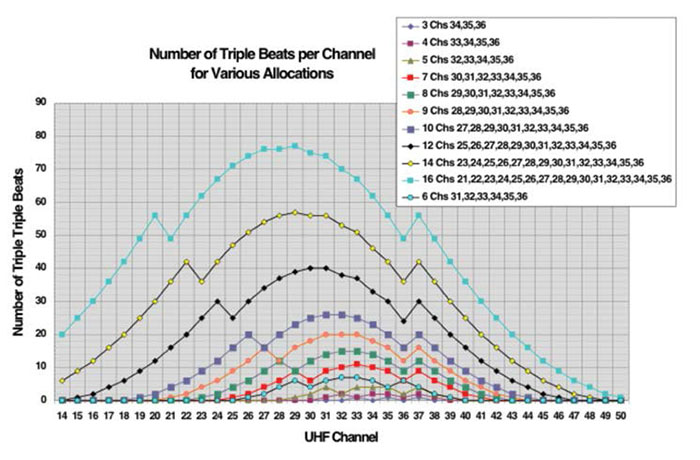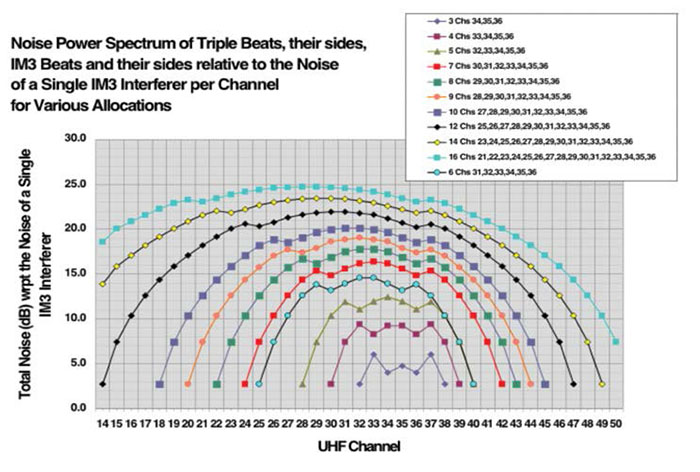Auction Over, Now Let’s Assess the Damage
With the end of the FCC’s spectrum auction in January, it’s time to measure its damaging effects on broadcasters.
What damage, you ask? Interference to reception of your signal after the “Great Repacking.”
The FCC claims negligible interference is predicted after repacking. If so, that would be great, but wouldn’t your station manager like to know? The FCC says only co-channel and (first) adjacent channel signals cause interference. Others are worried about interference generated in DTV receivers. There are three such sources for this interference:
● Desensitization not due to receiver nonlinearity;
● Third order intermodulation (IM3) due to receiver nonlinearity; and
● Triple beats, which require three signals, also due to receiver nonlinearity.
● Triple beats are generated when there are three or more strong undesired (U) signals at the receiver’s input. They come from:
Fa + Fb – Fc, Fb + Fc – Fa and Fc + Fa – Fb
The easiest way to work with triple beats is to let Fa equal the lowest channel number, Fb equal the middle channel number and Fc equal the highest channel number.
For example, suppose the FCC allocates four UHF channels to your community. You have three U signals on channels 24, 27, and 29. Triple beats will be centered on channels: 24 +27 – 29 = 22. Also on channel 27 + 29 – 24 = 32 and Channel 29 + 24 – 27 = 26. If your station is to operate on any of these three channels, there may be interference; if your station is not going to operate on any of these three channels, you are in luck!

Fig. 1THE EFFECTS OF TRIPLE BEATS
Fig. 1 shows the number of triple beats generated by all triplets of U signals in the UHF band. There can be no triple beats where the number of U signals is less than three (that is where the name “triple beats” comes from). Fig. 1 shows this and it also shows that where the number of U signals in the UHF band is greater than four, the number of triple beats increases at an amazing rate. There will be some communities with 11 or more UHF channels; the number of U signals will be 10, 11, or more. The number of triple beats is 360, but there aren’t that many UHF channels so there will be multiple triple beats falling in some channels.

Fig. 2 shows that the spectrum of triple beats can be extremely wide. In fact, channels 37–49 won’t really be TV channels anymore, they will belong to broadband operators. Nevertheless, triple beats will fall in the broadband spectrum where formerly channels 38–51 have been auctioned. Channel 37, which was never assigned to a TV station, was—and will continue to be—used for medical telemetry, primarily in hospitals and radio astronomy.
Fig. 2 Let’s look at the column for channel 7 in Fig. 2. The lowest trace is for three U signals and is centered on channel 35. Channel 37 will have six triple beats, which will increase the noise floor of telemetry receivers.

That was the good news. The bad news comes where the number of U signals is higher. With 10 U signals, the number of triple beats falling in channel 37 is 20.
The noise power of a single triple beat is 4 dB greater than a IM3 product, assuming the same power is in the U signals. This 4 dB difference is due to the fact that three signals are involved while only two generate IM3.
Fig. 3 Fig. 3 compares noise power density per channel of triple beats with respect to the noise power of a single IM3 for a number of U signals. For seven U signals that means eight channels allocated to the repacking process. This exceeds 15 db for eight channels! It gets worse with more channels allocated. The best case, of course, is three U signals, but even then the difference is 5 dB. All of this suggests a strategy by which the channels allocated to a given community can be used to minimize such interference.

If the chief engineers in a given large DMA— where there will be more than five stations in the UHF band—were to agree on a repacking scheme to minimize the number of triple beats, perhaps the FCC could be persuaded to grant their petition. If that is to be done, now is the time to start such a program.
Note: My friend and colleague, Stanley Knight, generated the data and created the three graphics for this column. Readers might like to know that Stan I have never met face-to-face. Nevertheless he collaborates with me generating all my graphics. Thanks, Stan.
Charles Rhodes is a consultant in the field of television broadcast technologies and planning. He can be reached via email atcwr@bootit.com.
Get the TV Tech Newsletter
The professional video industry's #1 source for news, trends and product and tech information. Sign up below.
